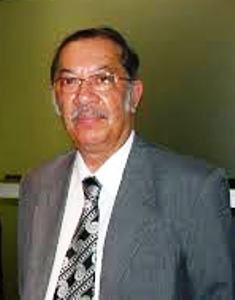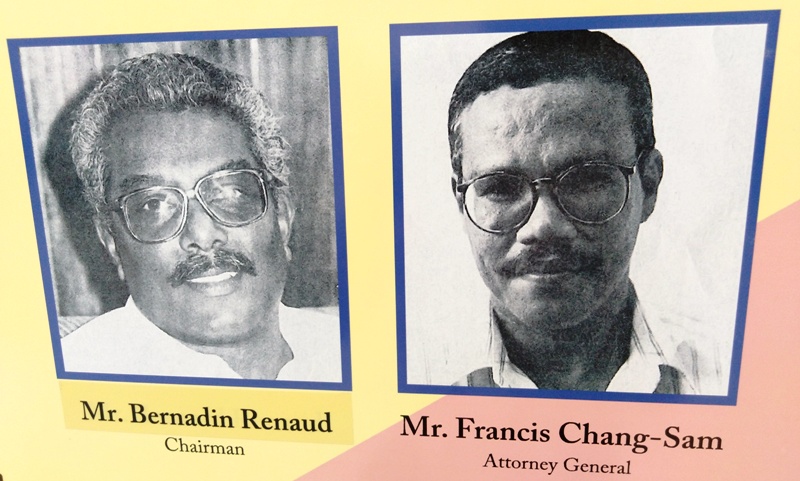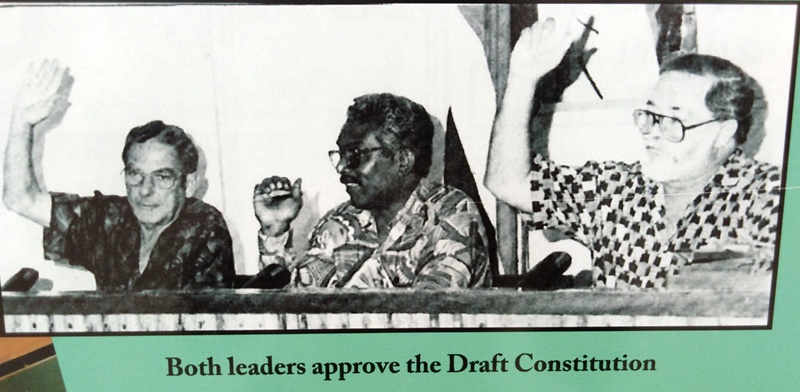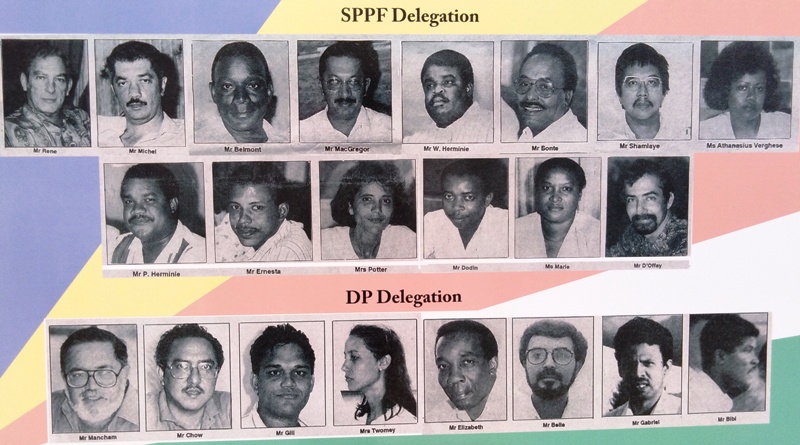The Constitutional years |16 June 2018
The first Constitutional Commission met on the August 27, 1992 at the People’s Assembly Hall, National House in Victoria  and was chaired by Justice Andre Sauzier as Director of Elections.
and was chaired by Justice Andre Sauzier as Director of Elections.
The leaders of both the parties in the Commission, Albert René for the Seychelles People’s Progressive Front (SPPF) and James Mancham for the Democratic Party (DP) made speeches at the ceremony.
Many distinguished guests were invited, including heads of churches, leaders of other political parties, diplomats and the Chief Justice. That meeting was also to designate a chairman and vice-chairman of the Commission who was to be from a different party. Joseph Belmont for SPPF was unanimously elected as chairman, whilst Bernard Elizabeth from the Democratic Party was unanimously elected as vice-chairman. The SPPF delegation was led by Minister Belmont while Democratic Party delegation was led by Paul Chow.
The Commission was meeting in the hall of the People’s Assembly which although still the Legislature, was clearly overshadowed as a national consultative forum for the people of Seychelles. For quite some time, then, most people “talked” constitution and became more conscious of it. It was and became like a big public focus with the public often reverently or otherwise referring to it as “la tab”.
The Constitution Commission concluded its work on October 12, 1992, and presented its draft to the people of Seychelles through a referendum held for the first time in Seychelles on November 15, 1992. The constitution requirement was that it had to have at least 60% majority voting in favour to be considered approved.
The vote was a simple YES or NO, with the YES vote obtaining 53.7% of the vote and the NO votes 46.3%, thereby failing to win the required approval.
It has been argued by some that provisions in the draft constitution on the rights to life v/s abortion, and a dogmatic or rigid approach by the SPPF led to failing to get the required consensus.
Righteously the Fourth Amendment of the existing 1979 Constitution provided provisions for the eventuality of the draft not being approved and consequently providing for the Constitutional Commission for the preparation of another draft and for resubmission to the people of Seychelles.
The reconvening of the Constitutional Commission was on January 11, 1993 at 9am with certain significant changes – the first being that the chairman was to be independent of the two parties in the Constitutional Commission, in the person of Bernadin Renaud, a practicing lawyer and former Chief Electoral Officer, the second was that both parties this time were to be led in the commission by their party leaders, namely France Albert Rene for the SPPF and James Mancham for the DP. The third change was that meetings of the Constitutional Commission were to be in public and fully covered by television and the press, and despite the composition and authority of the Constitutional Commission, the public and any interested persons could make submissions to the Constitutional Commission in person or in writing.
Further changes were in the composition of the Commission which included among others James Michel and young professionals like Dr Erna Athanasius, and there was more use of rotation of members. This resulted in more exposure and input.
These changes later turned out to be effective, particularly from then on with more of a spirit of give and take, dialogue, tolerance and as much as possible seeking consensus.
In particular, a sizeable amount of the public and interested groups sent views and submissions in writing. These submissions covered a wide range, from churches, institutes, individuals locally and abroad, businessmen, political parties, lawyers, trade unions, students, schools, political scientists and constitutional experts.
Notable among them was the Roman Catholic Mission through its Bishop Félix Paul who took three days to complete his submission in person. “The Reply” – I recall the sometimes pounding the SPPF delegation got from the Bishop in some of his criticism on the past rule of SPPF, its constitution and the future draft constitution. Some delegates were not far from boiling to respond, but the head of delegation calmly advised the chair they had no questions or anything to say. The Bishop himself was taken aback by this, and debate with other submissions continued. Other notable personalities included Dr Maxime Ferrari as chairman of the Seychelles Institute of Democracy, Bishop French Chang-Him of the Church of England, Wavel Ramkalawan of the then Parti Seselwa, the Chamber of Commerce, the Seychelles Hindu Kovil Sangam, the Seventh Day Adventist Mission, lawyers Bernard Georges and Ramnickal Valabhji, the Islamic Society of Seychelles, the Rastafarian community of Anse Boudin Praslin, Robert Frichot of the Seychelles National Movement, Gabby Hoareau of the SNM and Andre Sauzier former Attorney General, Judge and Director of Elections.
According to my records there were at least 115 submissions in writing and various organisations and personalities who also made their submission in person. The members of the Constitutional Commission could then question and dialogue with them.
The second Constitutional Commission met at least 43 times in public and in committee about 30 times. They were ably complimented and aided by a variety of advisers on both sides per party and per the whole commission through the able and industrious team of the then Attorney General, Francis Chang-Sam and his legal draftsman G. de Silva. Further to that were visiting constitutional experts of the likes of Professor Didier Maus from France, Geoff Robertson QC, Philipa Kaufman and William Menary from the United Kingdom, Guy Ollivry from Mauritius and Andre Terp from Canada.
Finally at the 45th and marathon session with some 11 hours of exercise we reached consensus on May 7, 1993. The draft Constitution was then ready for submission to the people of Seychelles in a referendum in only the second time in its history from June 15-18, 1993.
Prior to voting on the referendum was a vigorous campaign by the YES and NO campaign.
At the end of the campaign on that referendum the people of Seychelles decided with 73.9% in favour and 24.1% against.
The Constitution of the Third Republic was then born and took effect on June 18, 1993. That Constitution provided for election to a new legislature in the National Assembly and for the President of the Republic.
Accordingly, the logistics went into place for the first general elections in the Third Republic, and since the return of multiparty politics to Seychelles. The islands were to see the dawn of another era.
I must say looking back now a lot of work, patience, indulgence, fatigue, thinking and rethinking and some steam and hot air now and then went into the making of this new draft Constitution and the relative peace and stability it brought Seychelles.
Fortunately, providence, destiny, determination and the right spirit saw us through a period that could never be measured or imagined just by the relative 18 months we went through have been great quality time or more!!
Let history one day judge those persevering members of the Commission for what they were, what they went through, what they gave for what they thought was for a better Seychelles.



By Francis MacGregor




